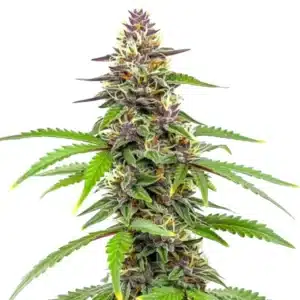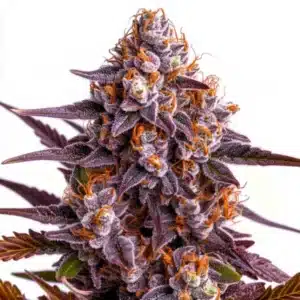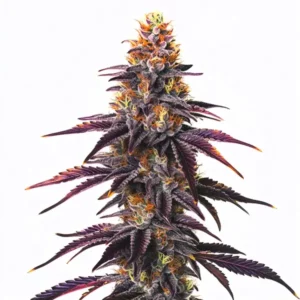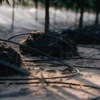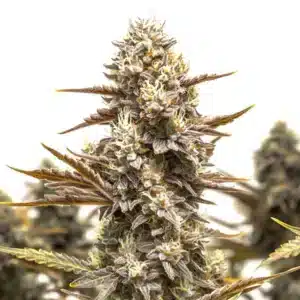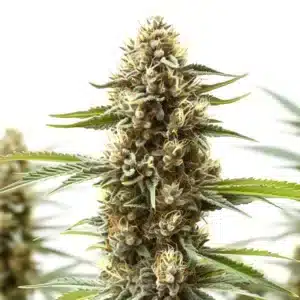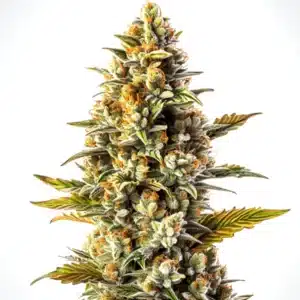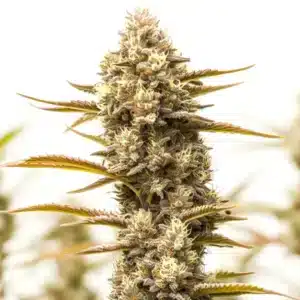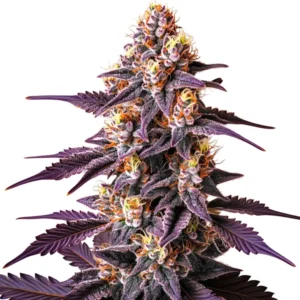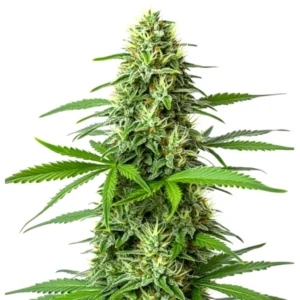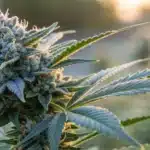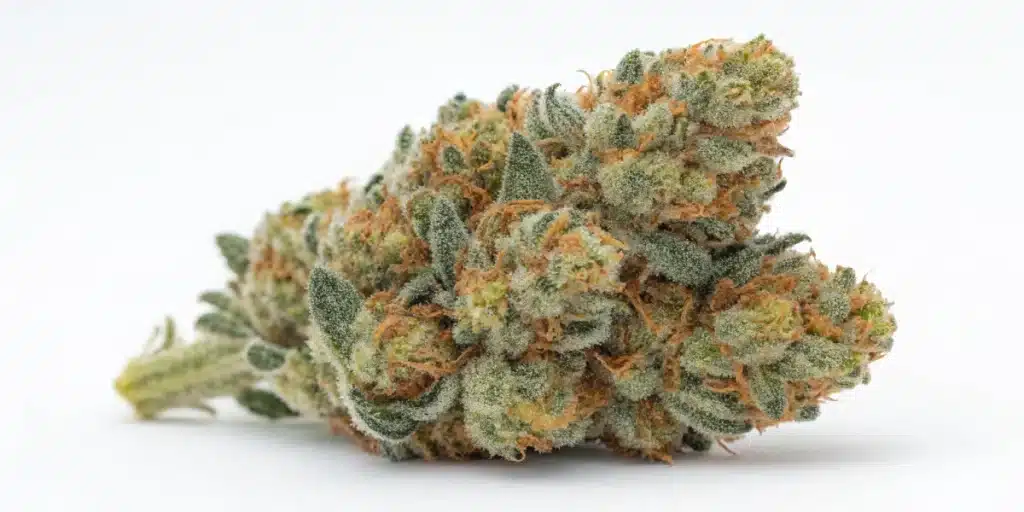
How to Grow Blue Headband Autoflower
Blue Headband Autoflower Description
Blue Headband Auto is a 50% Indica / 50% Sativa autoflower hybrid created by crossing Blueberry with 707 Headband and Ruderalis. It offers medium THC levels of 16%–18% alongside low CBD (0.2%), delivering a balanced experience of energy and relaxation. Users report an uplifting, euphoric head buzz paired with gentle body calm, ideal for daytime creativity or evening wind-down.
This variety completes its life cycle in just 8–9 weeks from seed to harvest, reaching about 4.92 ft (1.5 m) tall. Indoor yields range from 1.31–1.96 oz/ft² (500–600 g/m²), while outdoor plants can produce 3.5–7 oz (100–200 g) per plant under optimal conditions. Dense buds exude berry, citrus, lemon, and skunk aromas, driven by terpenes such as Alpha-Bisabolol, Eucalyptol, and Humulene.
Recommended Strains
Blue Head Band Auto
|
|
THC | 18% - 24% (Medium) |
|
|
Type | Autoflowering |
|
|
Yield | High |
|
|
Phenotype | 50% Indica / 50% Sativa |
Amnesia Blue Headband
|
|
THC | 10% - 20% (Medium) |
|
|
Type | Feminized |
|
|
Yield | Medium |
|
|
Phenotype | 50% Indica / 50% Sativa |
Therapeutically, Blue Headband helps anxiety (Caryophyllene), migraines (Myrcene-rich profiles), and pain (Myrcene & Humulene). Its autoflower genetics and forgiving temperament make it a top pick for beginners seeking reliable, high-quality results in a short timeframe.
Promos & Deals
Growing Environment
Indoors: Maintain daytime temperatures of 68–78 °F (20–26 °C) with a 5 °F drop at night. Keep relative humidity (RH) at 55%–65% during vegetative growth, reducing to 40%–50% once flowering begins to prevent mold and concentrate resin.
Outdoors: Select a sunny, sheltered spot with well-draining soil amended with compost or worm castings. Ensure at least six hours of direct light daily. In hot climates, provide afternoon shade; in cooler regions, use a hoop house or greenhouse to extend warmth and protect against rain.
Good airflow is crucial in both settings: use oscillating fans indoors and space outdoor plants 2–3 ft (0.6–0.9 m) apart to minimize humidity pockets and reduce pest pressure.
Setting Up Your Grow Space
Blue Headband Autoflower Indoor Cultivation
Use a 3×3 ft or 4×4 ft tent lined with reflective Mylar. Hang full-spectrum LED lights on an 18/6 schedule for the entire cycle. Install a carbon-filtered exhaust and intake vent to control odor and maintain fresh air. Position an oscillating fan at canopy level to strengthen stems and prevent heat spots.
Grow in 3–5 gal fabric pots filled with a light soil mix (pH 6.0–6.5) amended with perlite. Starting in final containers avoids transplant shock and encourages steady root development. Automate lighting, temperature, and humidity with digital controllers for consistent results.
Blue Headband Autoflower Outdoor Cultivation
Plant in raised beds or large fabric pots with a 2:1 mix of native soil and compost/perlite for drainage. Space plants 2–3 ft apart. Stake or cage young plants early to support future bud weight.
Water deeply when the top inch of soil dries, then allow slight drying to encourage robust root systems. Mulch around the base to conserve moisture and suppress weeds. Protect buds from heavy rain with a removable tarp during early flowering.
Seed Propagation and Germination
Soak seeds in distilled water for 12 hours to soften the shell. Place them between damp paper towels in a warm (75–80 °F/24–27 °C), dark spot. Within 24–48 hours, taproots should emerge. Transfer each seed taproot-down ½ in into moist starter mix under a humidity dome.
Provide 18–20 hours of gentle light until true leaves appear. Remove the dome gradually over 3–4 days to acclimate seedlings to ambient humidity and airflow. Label each pot to track growth and phenotype.
Blue Headband Autoflower Vegetative Phase
Maintain an 18/6 light schedule. Feed a nitrogen-rich nutrient solution (N-P-K 3-1-2) at 50% strength once per week. Employ low-stress training (LST) during weeks 2–3 to develop an even canopy and expose bud sites to light.
Keep temperatures at 68–78 °F and RH at 55%–65%. Introduce beneficial microbes or a kelp-based foliar spray early to strengthen roots. Prune shaded lower foliage to improve airflow and direct energy to the upper canopy.
Monitor runoff pH (6.0–6.5) and EC (1.2–1.8 mS/cm) weekly. Adjust nutrient strength based on plant response reduce if burn appears, or increase slightly if growth stalls.
Blue Headband Autoflower Flowering Phase
Bloom begins around week 4 without a light change. Continue 18/6 lighting or switch to 12/12 if preferred. Transition to a bloom nutrient higher in phosphorus and potassium (N-P-K 1-3-2) to support bud development and resin production.
Reduce humidity to 40%–50% and maintain daytime temps of 65–75 °F to concentrate terpenes. Around week 6, perform light defoliation remove large fan leaves blocking bud sites and support colas with soft ties or netting as they swell.
Begin flushing with plain, pH-balanced water in the final week to remove residual salts and improve taste, smoothness, and aroma in the finished product.
Fertilization and Nutrition
Veg (weeks 1–4): feed N-P-K 3-1-2 at half strength. Early bloom (weeks 5–6): switch to N-P-K 1-3-2. Late bloom (weeks 7–9): finish with N-P-K 0-3-3. Supplement calcium and magnesium if you observe yellowing or interveinal chlorosis.
Enrich soil with organic amendments worm castings, bone meal, kelp meal to feed the soil microbiome and boost terpene expression. A light foliar spray of seaweed extract in early bloom can enhance bud set without affecting root-zone pH.
Check runoff pH and EC; adjust feed solution concentration based on plant health and growth rate for optimal nutrient uptake and overall vigor.
Pest & Disease Control
Inspect plants daily for spider mites, aphids, and thrips. At the first sign of infestation, apply neem oil or insecticidal soap, thoroughly treating leaf undersides. Use yellow sticky traps to monitor and reduce flying pests.
Maintain strong airflow both indoors and outdoors to prevent powdery mildew and bud rot. Avoid overhead watering during flowering. Quarantine new plants for at least 7 days before introducing them to your main grow area to prevent pest and disease introduction.
Keep the grow environment clean remove dead leaves and sanitize tools regularly to break pest and disease cycles between grows.
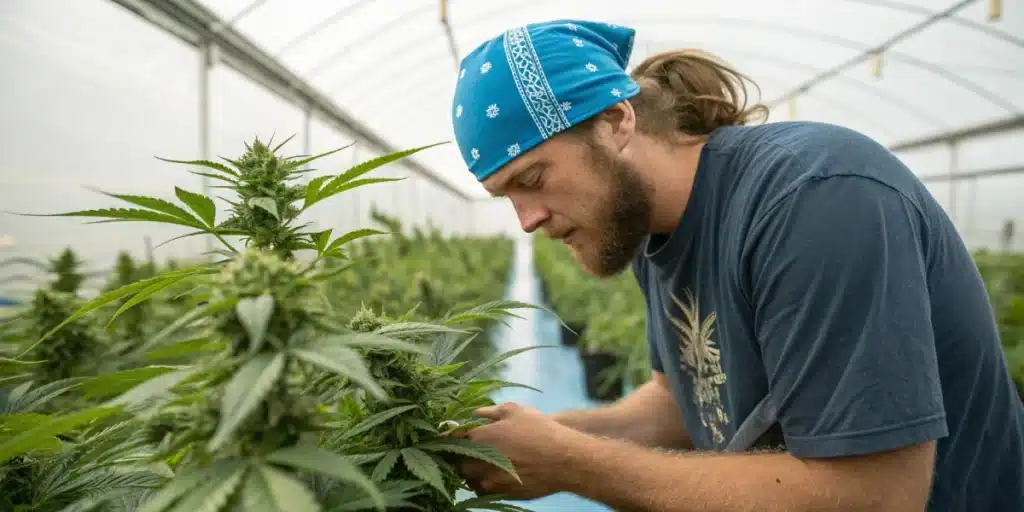
Blue Headband Autoflower Harvesting & Curing
Harvest when 70%–80% of trichomes are cloudy with occasional amber for balanced effects. Cut branches and trim large fan leaves immediately. Hang buds upside-down in a dark, ventilated room at 60–70 °F and 50% RH. Rotate branches every 2–3 days for even drying over 7–10 days.
Once stems snap cleanly, perform a detailed manicure remove sugar leaves and jar buds loosely in glass containers up to 75% full. “Burp” jars for 5–10 minutes daily during the first week, then weekly for 2–4 weeks. Use humidity packs to maintain 58%–62% RH for optimal curing.
Proper curing enhances aroma, flavor, and smoothness while preserving cannabinoids and terpenes. After 3–4 weeks, sample a small bud to verify the desired profile.
Post-Harvest: Drying, Curing & Storage
After curing, store buds in airtight glass jars with humidity regulators (e.g., Boveda packs) in a cool (60–65 °F), dark environment. For long-term storage beyond 6 months, vacuum-seal in Mylar bags with desiccants to minimize oxygen exposure. Label jars with strain and harvest date, and check monthly to rebalance humidity if needed.
Troubleshooting Common Issues
Nutrient Imbalances: Yellowing leaves often indicate nitrogen deficiency; brown, burnt tips signal nutrient burn. Correct by adjusting feed concentration or flushing with pH-balanced water, then resuming at half strength.
Environmental Stress: Heat stress causes leaf curl and wilting; light burn bleaches upper leaves. Raise light height, improve ventilation, and maintain temperatures below 80 °F. Use a humidifier if RH falls below 40%.
Watering & pH/EC: Overwatering leads to drooping and root issues; underwatering causes wilting. Water only when the top inch of soil is dry. Keep pH at 6.0–6.5 and EC at 1.2–1.8 mS/cm for optimal nutrient uptake.
Is Blue Headband Autoflower Indica or Sativa?
Blue Headband Autoflower is an even hybrid (50% Indica / 50% Sativa), offering both an uplifting cerebral high and soothing body relaxation perfect for balanced daytime or evening use.
Blue Headband Autoflower Advantages & Disadvantages
Advantages: Fast 8–9 week cycle, balanced effects, medium yields, beginner-friendly autoflower genetics, compact height for discreet grows.
Disadvantages: Requires precise humidity control to avoid mold, moderate yields compared to heavy-yielding strains, balanced high may be mild for heavy users.
Why Buy Blue Headband Autoflower Strain
Choose Blue Headband Autoflower for its rapid finish, balanced hybrid effects, and relief from anxiety, migraines, and pain. Autoflower genetics simplify cultivation no light-cycle changes needed.
Its berry-citrus aroma, forgiving nature, and consistent performance make it a standout for both novice and experienced growers seeking a quick, reliable harvest.
Similar Strains
Blueberry Auto
Blueberry Auto flowers in 8–9 weeks with sweet berry flavors and a relaxing Indica body high. Compact growth and beginner-friendly genetics mirror Blue Headband’s traits.
Headband Auto
Headband Auto finishes in 9 weeks, offering a balanced uplift and body relaxation. Its citrus-skunk aroma and medium yields align closely with Blue Headband’s profile.
Gorilla Glue Auto
Gorilla Glue 4 Auto a stable autoflower with heavy resin production and balanced effects. Completes in 9–10 weeks, delivering moderate yields and potent relaxation similar to Blue Headband’s therapeutic benefits.
Tips for Professionals
Automate environmental controls use digital thermostats, humidistats, and CO₂ supplementation during veg to enhance growth. Employ SCROG or SOG techniques to maximize canopy in limited spaces and boost yields.
Inoculate with mycorrhizae at transplant to strengthen root networks and improve nutrient uptake. Maintain detailed grow logs light schedules, feeding regimens, climate data and refine protocols for optimal cannabinoid and terpene expression.
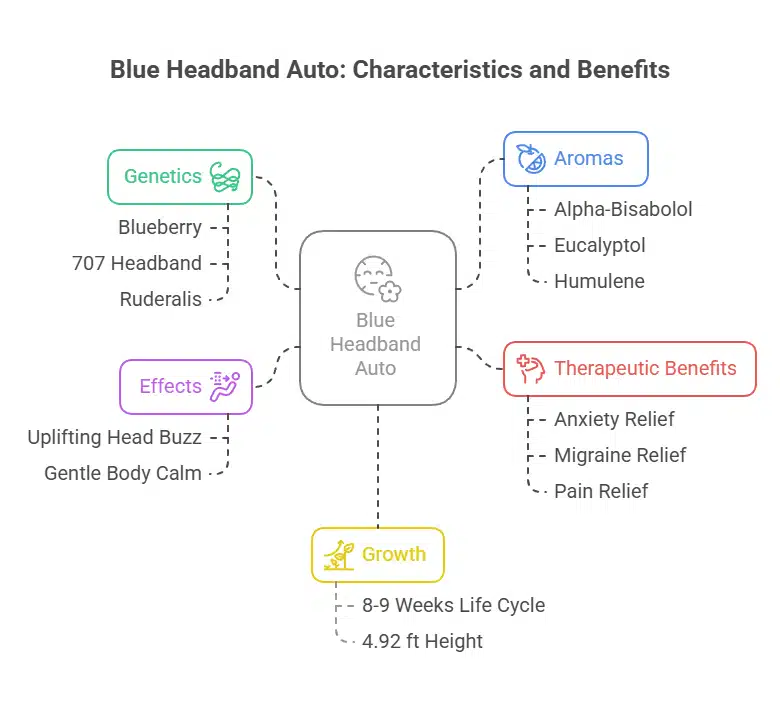
FAQs
How long does Blue Headband Autoflower take from seed to harvest?
It completes its full cycle in 8–9 weeks from seed to harvest, thanks to its autoflower genetics, allowing growers to plan multiple cycles per season.
Can I grow it outdoors in variable climates?
Yes its compact size and autoflower trait allow planting after the last frost. In hot zones, provide shade; in cooler areas, use a hoop house to maintain warmth.
What yields can I expect indoors vs. outdoors?
Indoor yields range from 1.31–1.96 oz/ft² (500–600 g/m²). Outdoor yields are 3.5–7 oz (100–200 g) per plant under optimal care and conditions.



